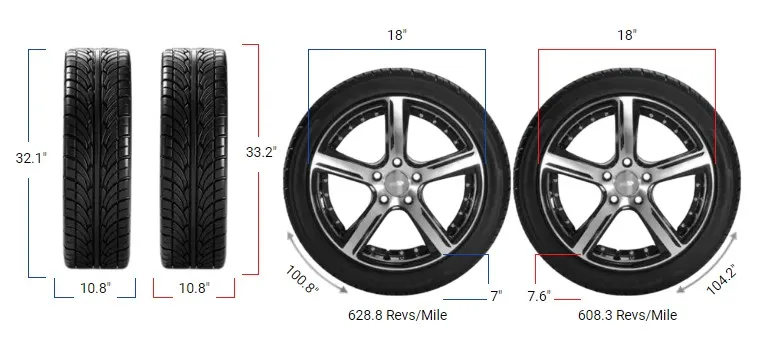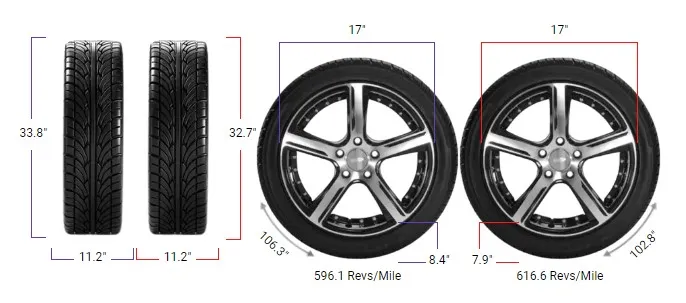Tire Size 225/65r17 vs 225/60r17

Switching from 225/65r17 to 225/60r17 tires involves a change in overall diameter and sidewall height. Let’s explore the key differences and impacts of this tire change to help you make an informed decision.
- Smaller diameter decreases ground clearance by 0.445 inches
- Lower profile may improve handling but reduce ride comfort
- Speedometer will read about 3.1% faster than actual speed
- Tire revolutions increase by 22.68 per mile affecting odometer readings
- No change in width maintains similar traction characteristics

Fitment Guide
The diameter difference between 225/65r17 and 225/60r17 tires is 3.1%, which slightly exceeds the recommended 3% threshold.
While this interchange is close to the acceptable range, it may require some adaptations to prevent potential issues like rubbing or clearance problems.
On-Road Impact
Switching to 225/60r17 tires will affect your vehicle’s on-road performance in several ways:
- Speedometer Accuracy: Your speedometer will read faster than your actual speed. When it shows 20 mph, you’ll actually be traveling at 19.38 mph. This 3.1% difference could lead to unintentional slower driving if not accounted for.
- Fuel Efficiency: The smaller 225/60r17 tires make 22.68 more revolutions per mile, a 3.2% increase. This might slightly decrease fuel efficiency due to increased rolling resistance, though the difference may be minimal in everyday driving.
- Handling: The lower profile of 225/60r17 tires could improve steering response and cornering ability. However, this may come at the cost of reduced comfort over bumps and potholes.
- Ride Comfort: With a 0.44-inch (7.7%) lower sidewall, 225/60r17 tires may provide a firmer ride. You might feel more road imperfections, especially on rougher surfaces.
- Aesthetics: The smaller diameter of 225/60r17 tires will reduce the gap between the tire and wheel well, giving your vehicle a slightly sportier look.

Off-Road Impact
For those who occasionally venture off-road, the switch to 225/60r17 tires will have these effects:
- Ground Clearance: Your vehicle’s ground clearance will decrease by about 0.445 inches. This reduction could make it slightly more challenging to navigate over large obstacles or through deep ruts.
- Traction: The lower sidewall of 225/60r17 tires might provide marginally better on-road traction due to reduced flex. However, it could slightly reduce off-road capability in softer terrains where tire deformation can be beneficial.
- Durability: The lower profile makes 225/60r17 tires more susceptible to damage from rocks and other off-road hazards. This could lead to more frequent tire replacements for frequent off-roaders.
- Comfort: The reduced sidewall height may result in a harsher ride on uneven off-road surfaces, potentially reducing comfort during extended off-road trips.

What is the Difference Between 225/65r17 and 225/60r17?
The main differences between 225/65r17 and 225/60r17 tires are in their dimensions. The 225/65r17 is larger overall, with a diameter of 28.52 inches compared to 27.63 inches for the 225/60r17.
Both tires have the same width of 8.86 inches. The 225/65r17 has a taller sidewall height of 5.76 inches versus 5.31 inches for the 225/60r17, and it makes fewer revolutions per mile.
Can I Use 225/60r17 Instead of 225/65r17?
While it’s possible to use 225/60r17 instead of 225/65r17, it’s not typically recommended without careful consideration.
The difference in diameter between these two tire sizes is 3.1%, which slightly exceeds the generally accepted 3% threshold for tire replacement.
This size difference could affect vehicle performance, speedometer accuracy, and potentially require some modifications to prevent rubbing or clearance issues.
How Much Taller Is a 225/65r17 Tire Than a 225/60r17?
A 225/65r17 tire is 0.89 inches (22.5 mm) taller than a 225/60r17 tire. The 225/65r17 has a diameter of 28.52 inches (724.3 mm), while the 225/60r17 has a diameter of 27.63 inches (701.8 mm). This represents a 3.1% difference in height.
225/65r17 vs 225/60r17 Table
Below is a comparison table of the 225/65R17 and 225/60R17 tire sizes, highlighting the differences in dimensions and performance.
| Feature | 225/65R17 | 225/60R17 | Difference |
|---|---|---|---|
| Diameter inches (mm) | 28.52 (724.3) | 27.63 (701.8) | -0.89 (-22.5) -3.1% |
| Width inches (mm) | 8.86 (225) | 8.86 (225) | 0 (0) 0% |
| Circumference inches (mm) | 89.58 (2275.46) | 86.8 (2204.77) | -2.78 (-70.69) -3.1% |
| Sidewall Height inches (mm) | 5.76 (146.25) | 5.31 (135) | -0.44 (-11.25) -7.7% |
| Revolutions per mile (km) | 707.26 (439.47) | 729.94 (453.56) | 22.68 (14.09) 3.2% |
| Speedo Reading | 20 mph | 19.38 mph | -0.62 mph |
Our Observation
Switching from 225/65r17 to 225/60r17 tires offers a mix of benefits and drawbacks. On-road, you may experience improved handling and a sportier look, but at the cost of ride comfort and slight speedometer inaccuracy.
The fuel efficiency impact is likely negligible for most drivers. Off-road, the smaller tires might reduce ground clearance and durability slightly, which could be noticeable for enthusiasts but less impactful for occasional off-road use.
The 3.1% size difference is just over the recommended limit, so minor vehicle adjustments may be necessary. Overall, this tire switch is more suited for drivers prioritizing on-road performance over off-road capability.



